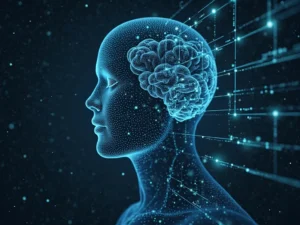Have you ever wondered, “How do AI detectors work?” These smart tools are changing how we identify AI-generated content, from essays to social media posts. In this guide, I’ll break down the fascinating tech behind them in simple terms—no jargon, just clear explanations.
What Are AI Detectors?
AI detectors are specialized tools designed to analyze text and determine whether it was written by a human or generated by artificial intelligence. These tools answer the key question: “How do AI detectors work?” by examining writing patterns, word choices, and sentence structures to identify signs of machine-generated content.
They serve an important role in education, content moderation, and digital publishing by helping maintain authenticity and prevent misuse of AI-generated text. Whether checking student essays, verifying online reviews, or ensuring original content creation, AI detectors provide a way to distinguish between human and AI writing.
By using advanced techniques like natural language processing (NLP) and machine learning, these tools compare submitted text against known AI writing patterns to deliver their assessments. While not perfect, they offer valuable insights in an increasingly AI-driven digital world.
Why Do We Need AI Detectors?
- Prevent AI-generated misinformation
- Ensure academic honesty
- Maintain human creativity in writing
If you’re curious about AI-generated content, check out our [previous content on AI writing tools](previous content link) to see how they compare.
How Do AI Detectors Work? The Core Mechanisms

AI detectors use advanced technology to determine whether a piece of text was written by a human or generated by artificial intelligence. These tools are becoming increasingly important in education, content moderation, and publishing. But how exactly do they work? Let’s break down the core mechanisms in simple terms.
1. Analyzing Writing Patterns
AI-generated text often follows predictable patterns because language models like GPT rely on statistical probabilities. Detectors examine:
- Repetitive phrases – AI tends to reuse certain structures
- Unusual word choices – Overly perfect or awkward phrasing
- Sentence length variation – Human writing has more natural flow
2. Measuring Perplexity and Burstiness
Two key metrics help AI detectors identify machine-generated content:
- Perplexity – Measures how unpredictable the word choices are (human writing scores higher)
- Burstiness – Analyzes variation in sentence structure (AI text is often more uniform)
3. Machine Learning Training
AI detectors are trained on massive datasets containing:
- Millions of human-written text samples
- AI-generated content from various models
This training helps them recognize subtle differences between human and machine writing styles.
4. Natural Language Processing (NLP) Techniques
Advanced NLP methods allow detectors to:
- Understand context and meaning
- Analyze grammar patterns
- Detect inconsistencies typical of AI writing
5. Statistical Analysis
Detectors run complex statistical checks on:
- Word frequency distributions
- Phrase repetition rates
- Syntax patterns
How Do AI Detectors Work in Real Applications?
These systems are constantly improving as AI writing tools evolve. While not perfect, they provide valuable assistance in maintaining content authenticity across multiple fields.
The technology behind how do AI detectors work combines linguistics, machine learning, and statistical analysis to spot the telltale signs of AI-generated text. As both detection and generation tools advance, this technological race will continue to develop new methods for identifying artificial content.
Key Technologies Behind AI Detectors

Understanding how AI detectors work requires a look at the core technologies powering them. These tools use advanced methods to distinguish between human-written and AI-generated content.
1. Natural Language Processing (NLP)
NLP is the foundation of AI detectors. It helps systems analyze grammar, context, and writing style by breaking down text structure and meaning.
2. Machine Learning Models
AI detectors rely on trained models to identify patterns. Common approaches include:
- BERT-based models (used by tools like OpenAI detector)
- Neural networks that classify text based on learned features
3. Statistical Analysis
Detectors examine statistical properties of text, such as:
- Word frequency (repetitive phrases are red flags)
- Sentence length variation (human writing tends to be less uniform)
4. Perplexity and Burstiness Measurement
- Perplexity checks how unpredictable word choices are—AI text often scores lower.
- Burstiness measures sentence rhythm; human writing has more natural flow changes.
These technologies work together to determine how AI detectors work effectively. As AI writing improves, detection methods continue evolving to stay accurate.
Are AI Detectors Accurate?
AI detectors have become essential tools for identifying machine-generated content, but many people wonder: Are AI detectors accurate? The answer isn’t simple—while they can be effective, their reliability depends on several factors.
How Accurate Are AI Detectors?
AI detectors analyze text using advanced algorithms, but they are not perfect. Here’s what affects their accuracy:
- Training Data Quality – Detectors perform better when trained on diverse datasets of both human and AI-written content.
- Evolving AI Models – As language models like GPT-4 improve, they mimic human writing more closely, making detection harder.
- False Positives & Negatives – Sometimes, human-written text is flagged as AI (false positive), while sophisticated AI content slips through (false negative).
Limitations of AI Detectors
Despite their advancements, AI detectors face challenges:
- Over-reliance on Patterns – They may mistake highly structured human writing (like technical reports) for AI-generated text.
- Bias Toward Certain Writing Styles – Informal or creative writing is harder to analyze than formal, predictable content.
- Lack of Universal Standards – Different detectors use varying methods, leading to inconsistent results.
How to Improve Detection Accuracy
If you rely on AI detectors, consider these tips:
- Use Multiple Tools – Cross-check results with different detectors (e.g., Turnitin, GPTZero, Copyleaks).
- Look for Context Clues – AI-generated text often lacks personal anecdotes or nuanced opinions.
- Stay Updated – As AI evolves, detection methods must adapt—newer models may require updated tools.
Common Uses of AI Detectors
AI detectors have become essential tools across various fields, helping to maintain authenticity and integrity in written content. Here’s how different industries use them:
1. Education: Ensuring Academic Honesty
- Schools and universities rely on AI detectors to identify AI-generated essays and assignments.
- Tools like Turnitin and GPTZero help educators spot potential plagiarism or unauthorized AI assistance.
- By flagging suspicious content, they promote original student work.
2. Content Moderation: Fighting Spam and Fake Reviews
- Websites and social media platforms use AI detectors to filter out:
- Automated spam comments
- Fake product reviews
- Low-quality AI-generated posts
- This keeps online discussions genuine and trustworthy.
3. Publishing and Journalism: Protecting Human Creativity
- Publishers and editors check manuscripts and articles to ensure they’re written by humans.
- AI detectors help maintain the unique voice and style of professional writers.
- They prevent mass-produced, generic content from flooding the market.
4. Business and Marketing: Verifying Authentic Content
- Companies use AI detectors to:
- Screen marketing copy for AI-generated text
- Ensure customer communications feel personal and human
- Avoid over-reliance on automated content that lacks originality
5. Legal and Compliance: Detecting AI-Generated Fraud
- Law firms and regulatory bodies use AI detectors to:
- Identify forged documents
- Spot AI-generated fake contracts or legal filings
- Prevent misinformation in official records
FAQs About How AI Detectors Work
1. How accurate are AI detectors?
AI detectors are improving but aren’t perfect. They can sometimes:
- Mistake human writing for AI-generated text (false positives)
- Miss advanced AI content that mimics human style well
Accuracy depends on the tool and the AI model being detected.
2. Can AI detectors identify all types of AI-generated content?
Most detectors work best with:
- English text from models like ChatGPT, Gemini, or Claude
- Longer pieces of writing (300+ words)
They may struggle with: - Short snippets of text
- Content that’s been heavily edited by humans
3. Do AI detectors work for non-English languages?
While most detectors focus on English:
- Some tools support major languages like Spanish, French, and German
- Accuracy is generally lower for non-English content
4. How can I make my AI-generated content pass detectors?
We don’t recommend trying to bypass detectors unethically. However, if you’re using AI assistance legitimately:
- Add personal insights and experiences
- Edit thoroughly to improve flow and uniqueness
- Mix AI-generated content with original writing
5. Are free AI detectors reliable?
Free tools can give you a general idea, but:
- Paid detectors (like Turnitin) are typically more accurate
- Enterprise solutions offer better security and features
6. How do AI detectors differ from plagiarism checkers?
- Plagiarism checkers look for copied content from existing sources
- AI detectors analyze writing patterns to identify machine-generated text
7. Will AI detectors become obsolete as AI improves?
As AI writing becomes more human-like:
- Detectors will need to evolve using more advanced techniques
- The cat-and-mouse game between generators and detectors will continue
8. Can AI detectors analyze images, audio, or video?
Most current detectors focus on text, but:
- Some tools are emerging for detecting AI-generated images and deepfakes
- Audio/video detection is more complex and less developed
Final Thoughts: How Do AI Detectors Work?
Understanding how do AI detectors work gives us valuable insight into the evolving relationship between human and machine-generated content. These tools represent an important technological advancement in maintaining authenticity across education, business, and digital communication.
At their core, AI detectors analyze writing patterns, word choices, and structural elements to distinguish between human and artificial intelligence authorship. While they’re not perfect, their ability to identify machine-generated text continues to improve alongside advancements in AI language models.
The effectiveness of AI detectors depends on several factors, including the quality of their training data, the sophistication of the AI being detected, and the length of the text being analyzed. As AI writing tools become more advanced, detectors must also evolve to keep pace with these changes.
Also Read: Beats Fit Pro vs AirPods Pro
For users, this means recognizing both the capabilities and limitations of detection technology. When used responsibly, AI detectors serve as valuable tools for preserving academic integrity, maintaining content quality, and promoting transparency in digital communications.
Ultimately, the question of how do AI detectors work leads us to broader considerations about the role of AI in our society and how we can harness these technologies while preserving human creativity and authenticity. As this technology continues to develop, staying informed about detection methods will help us navigate an increasingly AI-assisted world with greater awareness and understanding.






